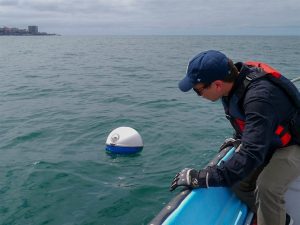Drifting Buoys Help Scientists Study Waves in the Gulf Stream
 On Saturday, December 14, 2019, two drifting buoys were deployed off OceanX’s Alucia ship in Miami to follow the Gulf Stream and track important ocean health and maritime safety conditions. Three more drifters are set to be deployed off the 184 foot research vessel over the next few weeks as it navigates to Lisbon, Portugal.
On Saturday, December 14, 2019, two drifting buoys were deployed off OceanX’s Alucia ship in Miami to follow the Gulf Stream and track important ocean health and maritime safety conditions. Three more drifters are set to be deployed off the 184 foot research vessel over the next few weeks as it navigates to Lisbon, Portugal.
Ocean surface drifting buoys, also called drifters, measure sea surface temperature, wind, and atmospheric pressure. The drifters currently being deployed from the Alucia also measure the period, height, and direction of surface waves. These Directional Wave Spectra Drifters are the first of their kind and the only observing tools in the open ocean measuring these physical properties of waves. There are currently about 100 of these wave drifters out of a total 1500 drifters of all types in the global array that is largely supported by NOAA Research. Data collected by drifters is sent in real-time via the Global Telecommunication System and helps researchers with models that predict oceanic trends, changing climate, and weather events such as hurricanes.
The five drifters on the Alucia will be deployed in the Gulf Stream, a powerful Western boundary current that transports heat from south to north in the Atlantic. The Gulf Stream influences temperatures and climate on the east coast of Florida and western European countries. Many countries depend on the Gulf Stream to transport goods, which makes this a prime location to study waves as they impact ship navigation and maritime safety.
Drifting buoys are part of NOAA’s Global Drifter Program, a joint program between NOAA and Scripps Institution of Oceanography at the University of California, San Diego. The Directional Wave Spectra Drifters were developed by the Lagrangian Drifter Lab at Scripps. Since their development, about 100 have been deployed in the ocean. Each year, NOAA deploys about 1000 drifters to maintain a global array of 1500 drifting buoys. In October 2018, five drifters were deployed in front of Hurricane Michael to help with hurricane forecast research.
The Global Drifter Program (GDP) is the largest component of the Global Surface Drifting Buoy Array, a branch of NOAA’s Global Ocean Observing System, supported by the Ocean Observing and Monitoring Division of NOAA Research. GDP is also a scientific project of the Data Buoy Cooperation Panel, an international program coordinating the use of autonomous data buoys to observe atmospheric and oceanographic conditions over ocean areas where few other measurements are taken. Over the last four decades, this program has supported the deployments of nearly 20,000 drifters.
For near real time data, check out Scripps’ drifter tracker page.